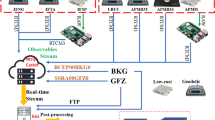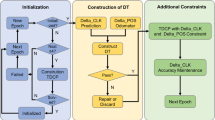Abstract
The signal-in-space ranging errors (SISREs), which are mainly dominated by clock errors, are computed for 18 BeiDou-3 (BDS-3) medium earth orbit satellites by comparing broadcast ephemeris values against precise values provided by Wuhan University from January 1 to December 31, 2019. For clock errors, a weighted least-square estimation method is carried out to eliminate the common clock error datum among all satellites. A standard deviation of 0.30 m indicates that the BDS-3 satellite clocks have good stability. However, as opposed to the near-zero means shown in the radial, along-track and cross-track directions of the orbit errors, satellite-specific nonzero means appear in the clock errors for most satellites and result in an RMS of 0.53 m for the whole satellite constellation. Dominated by the clock errors, the global average SISREs have an RMS of approximately 0.54 m, which demonstrates that the BDS-3 signal-in-space accuracy is at the same level as that of GPS. Super-Gaussian probability distributions fit the orbit and clock errors; however, the tails are not obviously heavier than that of a Gaussian distribution. Although the distribution of worst-case SISREs is bimodal, it could be overbounded by a Gaussian distribution with a mean of zero and a standard deviation of the user ranging accuracy (URA) with a certain confidence. To display Gaussian distribution models with different overbounding abilities, different URAs are estimated under various confidence levels based on actual SISRE samples. If the integrity risk is set to 10−5, the range of estimated URA values is 0.29–0.67 m for all satellites.









Similar content being viewed by others
Data availability
The newly merged BeiDou ephemeris data are made openly available by an anonymous user via ftp://159.226.162.31 or ftp://igmas.ntsc.ac.cn/BRDC in active mode. The files are named iggmddd0.yyf. The precise products from Wuhan University can be downloaded via ftp://igs.gnsswhu.cn/pub/gnss/products/mgex. The precise products from GFZ can be downloaded via ftp://ftp.gfz-potsdam.de/pub/GNSS/products/mgnss. The APC correction file provided by the CSNO can be found via http://www.beidou.gov.cn/yw/gfgg/201912/t20191209_19613.html.
References
Balanda K, Macgillivray H (1988) Kurtosis: a critical review. Am Stat 42(2):111–119
Blanch J, Walter T (2019) Lower bounds in optimal integrity monitoring. In: Proceedings of the ION 2019 Pacific PNT meeting, Institute of Navigation, Honolulu, Hawaii, USA, April 8–11, pp 915–924
Blanch J, Walter T, Enge P (2018) Gaussian bounds of sample distributions for integrity analysis. IEEE Trans Aerosp Electron Syst 55(4):1806–1815
Chen G, Hu Z, Wang G, Chen G, Liu Z, Zhao Q (2015) Assessment of BDS signal-in-space accuracy and standard positioning performance during 2013 and 2014. In: Proceedings of China satellite navigation conference (CSNC), Xian, China. Springer, Berlin, pp 437–453
Chen J, Hu X, Tang C, Zhou S, Yang Y, Pan J, Yu Y (2020) SIS accuracy and service performance of the BDS-3 basic system. Sci China Phys Mech Astron 63(6):269511
CSNO (2019a) Development of the BeiDou navigation satellite system (Version 4.0). http://www.beidou.gov.cn/xt/gfxz/201912/P020191227430565455478.pdf. Accessed 27 Dec 2019
CSNO (2019b) BeiDou Navigation Satellite System Signal In Space Interface Control Document Open Service Signal B1I (Version 3.0). http://www.beidou.gov.cn/xt/gfxz/201902/P020190227593621142475.pdf. Accessed 27 Feb 2019
CSNO (2019c) BeiDou satellite antenna phase center file. http://www.beidou.gov.cn/yw/gfgg/201912/t20191209_19613.html. Accessed 30 Dec 2019
DOD (2008) Global positioning system standard positioning service performance standard, 4th edn. US Department of Defense, Virginia
Galluzzo G et al (2018) Galileo system status, performance metrics and results. In: Proceedings of the ION ITM 2018, Institute of Navigation, Reston, Virginia, USA, January 29–31, pp 790–809
Guo J, Xu X, Zhao Q, Liu J (2015) Precise orbit determination for quad-constellation satellites at Wuhan University: strategy, result validation, and comparison. J Geod 90(2):143–159
Guo S, Cai H, Meng Y, Geng C, Jia X, Mao Y, Geng T, Rao Y, Zhang H, Xie X (2019) BDS-3 RNSS technical characteristics and service performance. Acta Geod Cartogr Sin 48(7):810–821
Heng L, Gao GX, Walter T, Enge P (2010) GPS signal-in-space anomalies in the last decade: data mining of 400,000,000 GPS navigation messages. In: Proceedings of the ION ITM 2010, Institute of Navigation, Portland, OR, USA, September 21–24, pp 3115–3122
Heng L, Gao GX, Walter T, Enge P (2011) Statistical characterization of GPS signal-in-space errors. In: Proceedings of the ION ITM 2011, Institute of Navigation, San Diego, CA, USA, January 24–26, pp 312–319
Heng L, Gao GX, Walter T, Enge P (2012) GLONASS signal-in-space anomalies since 2009. In: Proceedings of the ION GNSS 2012, Institute of Navigation, Nashville, Tennessee, USA, September 17–21, pp 833–842
Hu Z, Chen G, Zhang Q, Guo J, Su X (2013) An initial evaluation about BDS navigation message accuracy. In: Proceedings of China satellite navigation conference (CSNC) 2013, Wuhan, China, May 15–17. Springer, Berlin, pp 479–491
Jiao W, Ding Q, Li J, Lu X, Feng L, Ma J, Chen G (2011) Monitoring and assessment of GNSS open services. J Navig 64(S1):S19–S29
Lv Y, Geng T, Zhao Q, Liu J (2018) Characteristics of BDS-3 experimental satellite clocks. Remote Sens 10(11):1847
Lv Y, Geng T, Zhao Q, Xie X, Zhou R (2019) Initial assessment of BDS-3 preliminary system signal-in-space range error. GPS Solut 24(1):16
Misra P, Enge P (2006) Global positioning system: signals, measurements, and performance, 2nd edn. Ganga-Jamuna Press, Lincoln
Montenbruck O, Steigenberger P, Hauschild A (2015) Broadcast versus precise ephemerides: a multi-GNSS perspective. GPS Solut 19(2):321–333
Montenbruck O, Steigenberger P, Hauschild A (2018) Multi-GNSS signal-in-space range error assessment-methodology and results. Adv Space Res 61(12):3020–3038
Renfro BA, Terry A, Boeker N (2017) An analysis of global positioning system (GPS) standard positioning system (SPS) performance for 2016, TR-SGL-17-06. Applied Research Laboratories, The University of Texas at Austin
Renfro BA, Stein M, Boeker N (2019) An analysis of global positioning system (GPS) standard positioning system (SPS) performance for 2018, TR-SGL-19-02. Applied Research Laboratories, The University of Texas at Austin
Sośnica K, Zajdel R, Bury G, Bosy J, Moore M, Masoumi S (2020) Quality assessment of experimental IGS multi-GNSS combined orbits. GPS Solut 24(2):54
Steigenberger P, Montenbruck O (2017) Galileo status: orbits, clocks, and positioning. GPS Solut 21(2):319–331
Walter T, Blanch J (2015) Characterization of GPS clock and ephemeris errors to support ARAIM. In: Proceedings of the ION 2015 Pacific PNT meeting, Institute of Navigation, Honolulu, Hawaii, USA, April 20–23, pp 920–931
Walter T, Blanch J, Gunning K (2019) Standards for ARAIM ISM data analysis. In: Proceedings of the ION 2019 Pacific PNT meeting, Institute of Navigation, Honolulu, Hawaii, USA, April 8–11, pp 777–784
Wang H, Jiang H, Ou J, Sun B, Zhong S, Song M, Guo A (2018) Anomaly analysis of 18 years of newly merged GPS ephemeris from four IGS data centers. GPS Solut 22(4):124
Wu Y, Liu X, Liu W, Ren J, Lou Y, Dai X, Fang X (2017) Long-term behavior and statistical characterization of BeiDou signal-in-space errors. GPS Solut 21(4):1907–1922
Yang Y, Gao W, Guo S, Mao Y, Yang Y (2019) Introduction to BeiDou-3 navigation satellite system. Navigation 66(1):7–18
Zhang Q, Sui L, Jia X (2014) SIS error statistical analysis of BeiDou satellite navigation system. Geo Inf Sci Wuhan Univ 39(3):217–274
Zhang Y, Kubo N, Chen J, Wang J, Wang H (2019) Initial positioning assessment of BDS new satellites and new signals. Remote Sens 11(11):1320
Zhang Y, Wang H, Chen J, Wang A, Meng L, Wang E (2020) Calibration and impact of BeiDou satellite-dependent timing group delay bias. Remote Sens 12(1):192
Zhao Q, Wang C, Guo J, Wang B, Liu J (2017) Precise orbit and clock determination for BDS-3 experimental satellites with yaw attitude analysis. GPS Solut 22(1):4
Acknowledgements
The authors gratefully acknowledge the support of the National Natural Science Foundation of China (Grant No. 41474029) and the Collaborative Precision Positioning Project funded by the Ministry of Science and Technology of China (No. 2016YFB0501900). In response to the reviewers’ comments, the work was improved by the discussion with Professor Baoqi Sun at National Time Service Center, Chinese Academy of Sciences, on BDS-3 orbit dynamics and SISE correlation analysis.
Author information
Authors and Affiliations
Corresponding author
Additional information
Publisher's Note
Springer Nature remains neutral with regard to jurisdictional claims in published maps and institutional affiliations.
Rights and permissions
About this article
Cite this article
Xue, B., Wang, H. & Yuan, Y. Performance of BeiDou-3 signal-in-space ranging errors: accuracy and distribution. GPS Solut 25, 23 (2021). https://doi.org/10.1007/s10291-020-01057-z
Received:
Accepted:
Published:
DOI: https://doi.org/10.1007/s10291-020-01057-z




